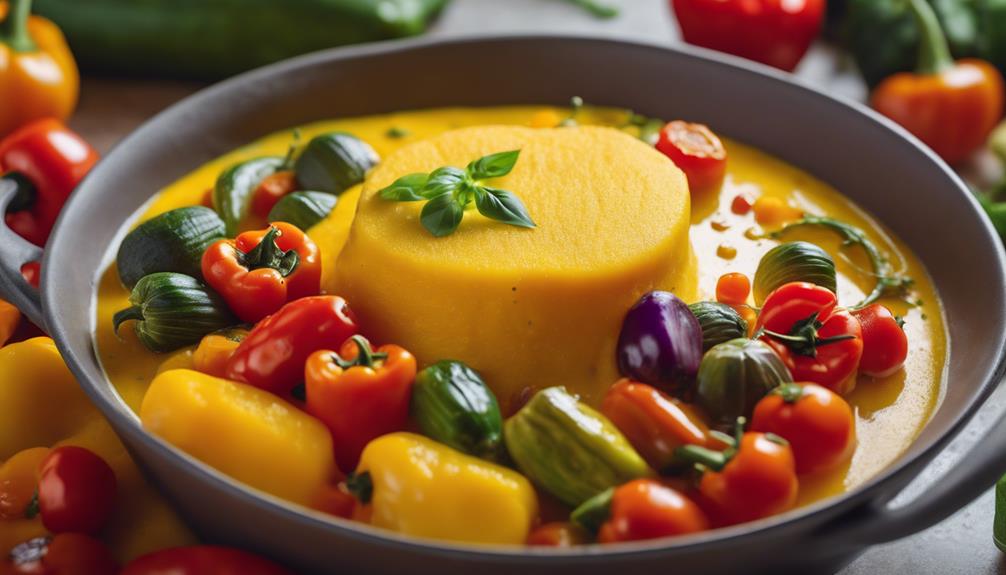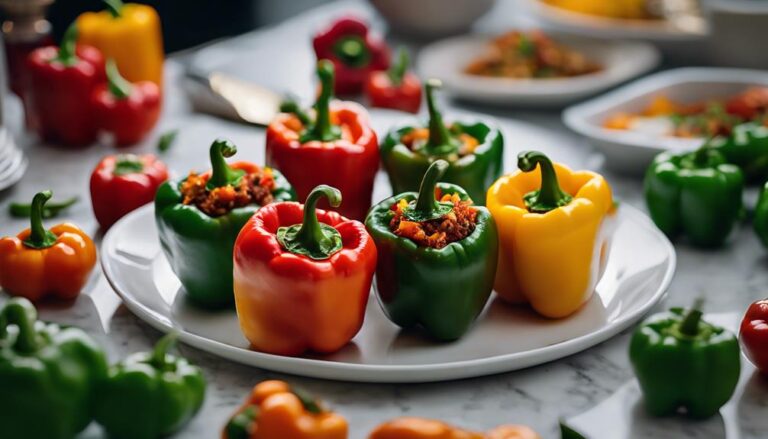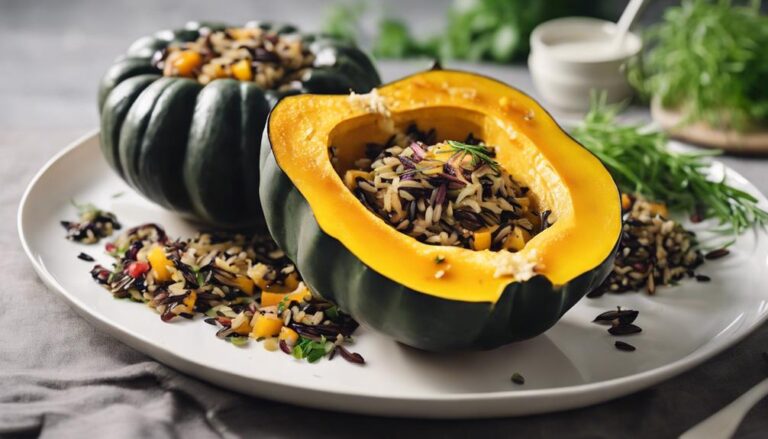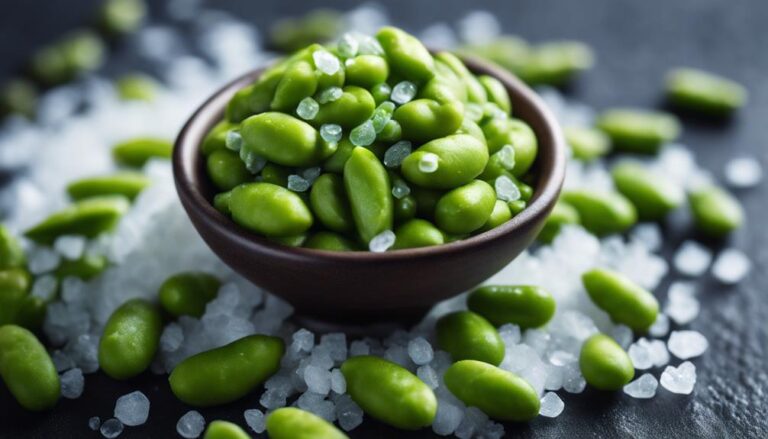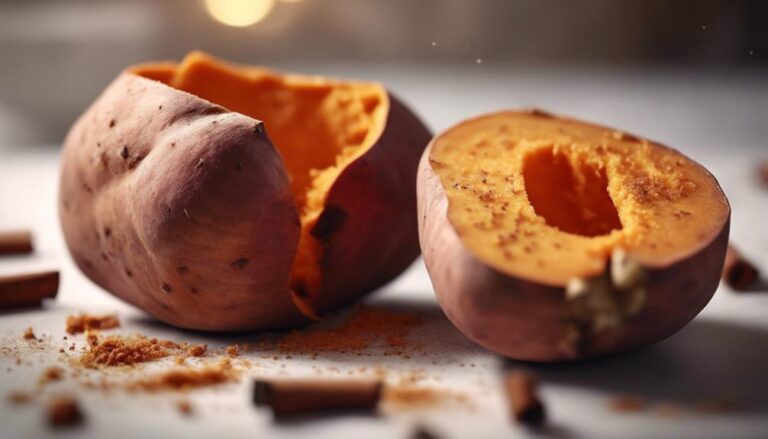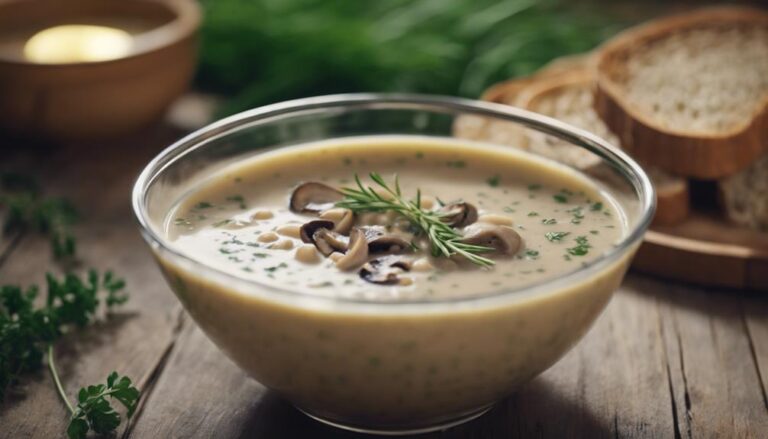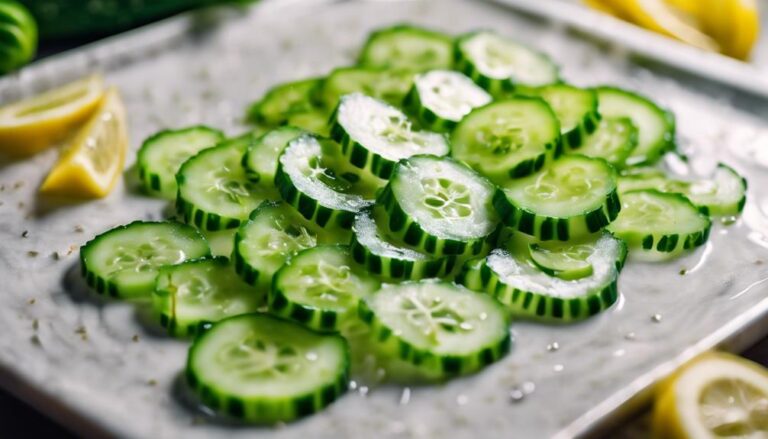Sous Vide Polenta With Roasted Vegetable Ragout
Immerse yourself in the velvety charm of sous vide polenta paired with a robust roasted vegetable ragout, creating an exquisite symphony of flavors. Achieve a flawless creaminess in your polenta by blending milk and stock, cooking sous vide at 185°F for 2 hours, then stirring in butter and Parmesan cheese for a silky finish. Enhance your culinary skills by experimenting with various polenta variations like sun-dried tomatoes or herb-infused options. Maximize the full potential of your kitchen prowess with this delectable dish. Elevate your dining experience with sous vide polenta and roasted vegetable ragout for a memorable meal.
What You Will Learn Here
- Sous vide polenta offers a creamy base for the roasted vegetable ragout.
- Roasted vegetable ragout complements the richness of sous vide polenta.
- Sous vide cooking ensures precise temperature control for both polenta and vegetables.
- Experiment with various vegetables like bell peppers, zucchini, and eggplant for the ragout.
- The sous vide method enhances flavors and textures, creating a harmonious dish with polenta and roasted vegetables.
Polenta's Italian Origins
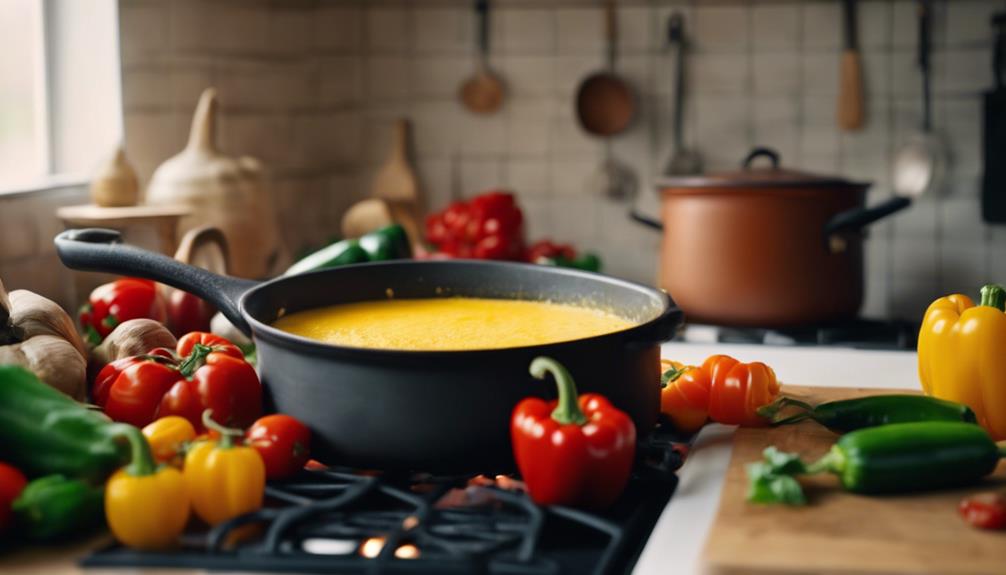
Imagine yourself transported to the rustic kitchens of Northern Italy, where the tradition of crafting polenta from coarsely ground cornmeal first began.
Picture the humble beginnings of this dish, once a staple for Italian peasants, now celebrated worldwide for its versatility and rich history.
Let's explore the roots of polenta, its traditional preparation, and the myriad ways it can be enjoyed today.
Polentas Italian History
With its humble origins in Northern Italy, polenta has stood the test of time as a beloved staple in Italian cuisine for centuries. Originally made with cornmeal, water, and salt, this dish was cooked to a creamy consistency, making it a filling and versatile option. Polenta was historically considered peasant food due to its simple ingredients, but its delicious taste and adaptability quickly made it popular across all social classes. In Italy, it is often served as a side dish with various toppings or incorporated into casseroles and stews. The evolution of polenta's preparation methods over time has led to modern variations such as sous vide polenta, ensuring a consistent and convenient result that still honors the rich history of this traditional dish.
| Fun Fact | Did You Know? |
|---|---|
| Creamy Consistency | Polenta was traditionally cooked to a creamy texture, making it a comforting and satisfying dish. |
| Peasant Food | Despite its humble beginnings, polenta gained popularity and became a staple in Italian cuisine enjoyed by all social classes. |
| Versatile Dish | Polenta can be served in various ways, either as a simple side dish or as a key ingredient in more elaborate recipes like casseroles and stews. |
Traditional Polenta Preparation
Traditional polenta preparation in Italy involves slow cooking coarsely ground cornmeal with water or stock until it thickens into a creamy consistency, a method that has been a culinary tradition in Northern Italy for centuries.
This traditional approach to making polenta isn't just a cooking method but a cultural heritage deeply rooted in Italian cuisine. The essential cooking process is vital, allowing the cornmeal to absorb the liquid fully, developing rich flavors and a smooth texture.
In Italy, polenta was traditionally prepared in large copper pots over open flames, requiring constant attention and skillful stirring. This dedication to crafting the perfect polenta showcases the importance of tradition and authenticity in Italian culinary practices.
Embrace this time-honored tradition to create a dish that truly embodies the essence of Italy.
Versatility in Polenta
Investigating the diverse culinary possibilities of polenta reveals a rich tapestry of Italian gastronomic heritage and creativity. The Italians' love for this cornmeal dish transcends generations, with its origins deeply rooted in Northern Italy.
Whether served creamy, firm, or crispy, polenta's versatility shines through when paired with various toppings and sauces. From being sous vide poached to crisped up on the grill, the adaptability of polenta knows no bounds. Its ability to transform from smooth and creamy to firm and sliceable makes it a star ingredient in dishes like the delectable Vegetable Ragout.
As Italian immigrants introduced polenta to the United States, its popularity soared, finding a place in many households and restaurants, showcasing its enduring appeal and delicious charm.
Polenta's Key Seasoning Ingredients
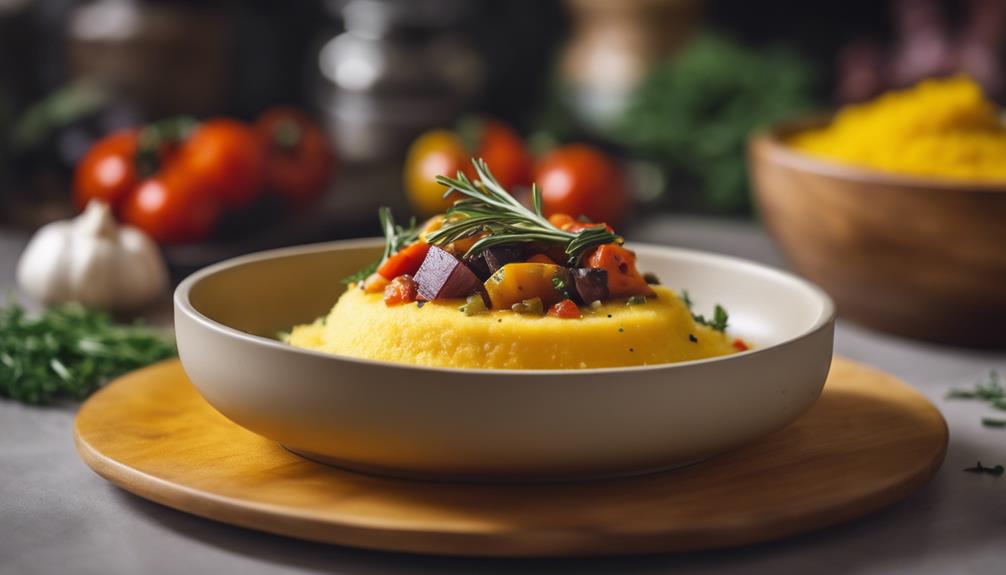
Enhance the creamy and savory base of your polenta with key seasoning ingredients such as salt, pepper, butter, and Parmesan cheese. These ingredients work harmoniously to elevate the flavor profile of your polenta, creating a dish that's rich, decadent, and utterly satisfying.
- Salt and Pepper: These fundamental seasonings are the backbone of flavor in your polenta, enhancing the overall taste and bringing out the natural sweetness of the cornmeal.
- Butter: Adding butter to your polenta not only infuses it with richness but also contributes to a velvety smooth texture that's pure comfort in every bite.
- Parmesan Cheese: The nuttiness and saltiness of Parmesan cheese marry beautifully with the cornmeal, creating a depth of flavor that's both comforting and indulgent.
Sous Vide Polenta Variations
When it comes to sous vide polenta, the potential for delicious variations is vast and exciting.
You can experiment with Polenta With Sun-Dried Tomatoes for a burst of tangy flavor, try an Herb-infused Polenta Recipe for a fragrant twist, or opt for a Creamy Parmesan Polenta Recipe for a rich and savory experience.
Each variation opens up a world of culinary possibilities, inviting you to explore and savor the diverse flavors and textures that sous vide polenta can offer.
Polenta With Sun-Dried Tomatoes
Infuse your sous vide polenta with a burst of rich and concentrated flavor by incorporating sun-dried tomatoes during cooking.
The sweetness of sun-dried tomatoes complements the creamy texture of sous vide polenta perfectly, creating a symphony of flavors in every bite.
Sun-dried tomatoes add depth and complexity to the polenta, enhancing the overall dish with their rich umami and tangy notes.
Experiment with different quantities of sun-dried tomatoes to find the perfect balance that suits your taste preferences, allowing you to tailor this dish to your liking.
Elevate your culinary experience by embracing the versatility and robust flavors that sun-dried tomatoes bring to your polenta, turning a simple dish into a gourmet delight.
Herb-infused Polenta Recipe
Elevate your sous vide polenta experience with a burst of flavor by infusing it with a blend of aromatic herbs like basil, marjoram, and thyme. The herb-infused polenta is a flavorful variation that will tantalize your taste buds and elevate your culinary creations.
Using fresh herbs not only enhances the taste and aroma of the polenta but also adds a vibrant and fresh element to your dish, creating a more dynamic and fragrant experience. Customize your herb-infused polenta by adjusting the types and amounts of herbs to suit your personal preferences and taste profile.
Embrace the delicious possibilities that fresh herbs bring to your cooking with this herb-infused polenta recipe.
- Indulge in the rich aroma of basil, marjoram, and thyme.
- Elevate your dish with a burst of fresh herb flavors.
- Create a culinary masterpiece with herb-infused polenta.
Creamy Parmesan Polenta Recipe
Have you ever experienced the luxurious creaminess of Parmesan-infused polenta cooked to perfection using the sous vide method? This creamy Parmesan polenta recipe is a culinary delight that will elevate any meal.
Here are three reasons to indulge in this delectable dish:
- Cooking the polenta in a sous vide water bath at 185°F for 2 hours guarantees a consistently smooth and creamy texture.
- The addition of grated Parmigiano-Reggiano cheese at the end infuses the polenta with a rich, savory flavor.
- Serve this decadent sous vide polenta alongside dishes like short ribs or pork shanks for a gourmet dining experience that will impress even the most discerning palates.
Polenta Texture Secrets
To uncover the perfect polenta texture, consider the type of cornmeal, liquid used for cooking, and seasonings added. These factors play a vital role in achieving a creamy consistency that complements your dish.
Discover the secrets to enhancing your polenta's texture and explore the art of crafting a delectably smooth and flavorful dish.
Polenta Consistency Tips
Achieve the perfect polenta consistency by incorporating the ideal 4:1 liquid to polenta ratio and stirring continuously for a smooth, creamy texture. The key to achieving that desired creaminess lies in the balance of liquid amount and cooking time.
Stirring prevents lumps and guarantees a velvety finish. If you prefer a firmer texture, reduce the liquid slightly and extend the cooking time. Remember, the cooking time and liquid amount are customizable based on your personal preference for polenta consistency.
To elevate the creaminess, consider adding butter or cheese for a richer flavor and smoother mouthfeel. Mastering these tips will result in a delectable polenta that will complement your dishes beautifully.
Achieving Creamy Texture
For a polenta texture that is luxuriously smooth and creamy, incorporating a blend of milk and stock is a game-changing secret. This combination adds richness and depth of flavor while ensuring a velvety consistency that will elevate your dish to a whole new level. When cooking sous vide at 185°F for 2 hours, the precise temperature control prevents lumps and results in a consistently creamy polenta texture. Using a zipper-top gallon-sized freezer bag for sous vide cooking is key as it helps retain moisture, ensuring your polenta stays perfectly creamy. Finish by stirring in butter and Parmesan cheese at the end of cooking to enhance the creaminess even further.
| Sous Vide Secrets |
|---|
| Milk and stock blend |
| Zipper-top freezer bag |
| Precise temperature control |
| Butter and Parmesan cheese |
| Velvety consistency |
Texture Enhancing Techniques
Choose a harmonious blend of ingredients to reveal the full potential of your polenta's texture, creating a sublime dining experience.
When employing sous vide techniques, you unearth the key to achieving a creamy texture that will elevate your dish to new heights. The precise temperature control in sous vide cooking guarantees consistent and even cooking, resulting in a velvety smoothness that's unmatched.
By harnessing the power of sous vide, you preserve the natural flavors and nutrients of the cornmeal, enriching the texture of your polenta. Say goodbye to the constant stirring and monitoring; with sous vide, your polenta will emerge perfectly smooth and luscious every time.
Embrace this method to preserve your polenta until serving, maintaining its ideal texture and quality for a truly memorable meal.
Final Thoughts
In conclusion, the union of sous vide polenta and roasted vegetable ragout elevates a traditional dish to a new level of culinary delight. The sous vide method guarantees that the polenta achieves a perfect creamy texture, making each bite a luxurious experience. Pairing this creamy polenta with the rich flavors of the roasted vegetables creates a harmonious balance that delights the taste buds.
The meticulous process of sous vide cooking ensures that the polenta is cooked precisely, resulting in a consistently smooth texture that complements the hearty roasted vegetables. This dish not only offers convenience but also presents a symphony of flavors that dance on your palate.
Frequently Asked Questions
Should Polenta Be Soaked Before Cooking?
For ideal polenta texture, skip soaking. Enhance flavor absorption and decrease soaking time. Follow precise cooking instructions for the best results. Adjust water ratio to achieve creamy or firm texture. Trust the process!
Can You Overcook Polenta?
You can overcook polenta, affecting its texture, flavor, and overall appeal. Monitoring cooking time closely is crucial to prevent it from becoming mushy and bland. Meticulous attention to detail guarantees a perfect balance of creaminess and taste.
Is Precooked Polenta Good?
When you select precooked polenta, you compromise some texture and flavor compared to freshly made. Cooking time is reduced, but make sure you check labels for additives affecting taste. For best results, consider enhancing flavor retention with fresh ingredients.
How Do You Reheat Polenta Sous Vide?
To reheat polenta sous vide, place the sealed bag in a 140°F water bath for about 30 minutes. Gently massage the bag to guarantee even heating. Avoid overheating to preserve texture. Sous vide preserves flavor and creaminess, enhancing your dining experience.
Conclusion
Indulge in the rich flavors and creamy texture of sous vide polenta with roasted vegetable ragout.
Discover the Italian roots of this versatile dish and experiment with different seasoning variations to suit your taste preferences.
With the help of sous vide cooking, you can achieve the perfect polenta texture every time.
Elevate your culinary skills and impress your guests with this exquisite dish that's sure to leave a lasting impression.
Bon appétit!
